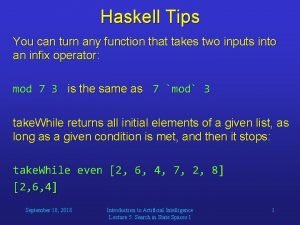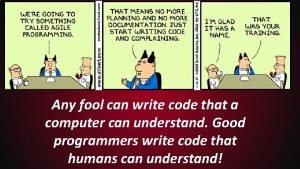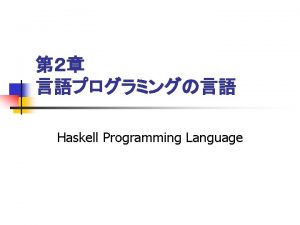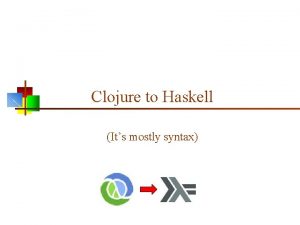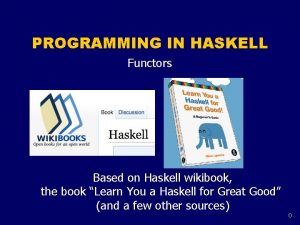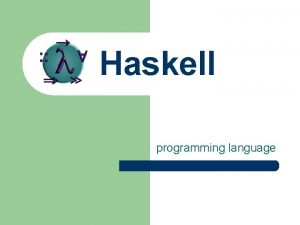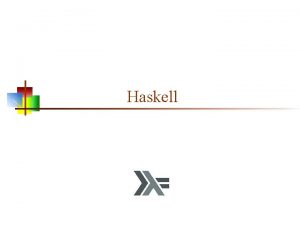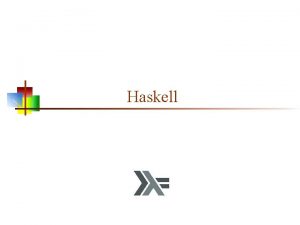Haskell Tips You can turn any function that


















- Slides: 18

Haskell Tips You can turn any function that takes two inputs into an infix operator: mod 7 3 is the same as 7 `mod` 3 take. While returns all initial elements of a given list, as long as a given condition is met, and then it stops: take. While even [2, 6, 4, 7, 2, 8] [2, 6, 4] September 18, 2018 Introduction to Artificial Intelligence Lecture 5: Search in State Spaces I 1

Search in State Spaces September 18, 2018 Introduction to Artificial Intelligence Lecture 5: Search in State Spaces I 2

Search in State Spaces • Many problems in Artificial Intelligence can be mapped onto searches in particular state spaces. • This concept is especially useful if the system (our “world”) can be defined as having a finite number of states, including an initial state and one or more goal states. • Optimally, there a finite number of actions that we can take, and there are well-defined state transitions that only depend on our current state and current action. September 18, 2018 Introduction to Artificial Intelligence Lecture 5: Search in State Spaces I 3

Search in State Spaces • To some extent, it is also possible to account for state changes that the algorithm itself does not initiate. • For example, a chess playing program can consider its opponent’s future moves. • However, it is necessary that the set of such actions and their consequences are well-defined. • While computers are able to play chess at a very high level, it is impossible these days to build a robot that, for instance, is capable of reliably carrying out everyday tasks such as going to a supermarket to buy groceries. September 18, 2018 Introduction to Artificial Intelligence Lecture 5: Search in State Spaces I 4

Search in State Spaces Let us consider an easy task in a very simple world with our robot being the only actor in it: • The world contains a floor and three toy blocks labeled A, B, and C. • The robot can move a block (with no other block on top of it) onto the floor or on top of another block. • These actions are modeled by instances of a schema, move(x, y). • Instances of the schema are called operators. September 18, 2018 Introduction to Artificial Intelligence Lecture 5: Search in State Spaces I 5

Search in State Spaces • The robot’s task is to stack the toy blocks so that A is on top of B, B is on top of C, and C is on the floor. • For us it is clear what steps have to be taken to solve the task. • The robot has to use its world model to find a solution. • Let us take a look at the effects that the robot’s actions exert on its world. September 18, 2018 Introduction to Artificial Intelligence Lecture 5: Search in State Spaces I 6

Search in State Spaces Effects of moving a block (illustration and list-structure iconic model notation) September 18, 2018 Introduction to Artificial Intelligence Lecture 5: Search in State Spaces I 7

Search in State Spaces • In order to solve the task efficiently, the robot should “look ahead”, that is, simulate possible actions and their outcomes. • Then, the robot can carry out a sequence of actions that, according to the robot’s prediction, solves the problem. • A useful structure for such a simulation of alternative sequences of action is a directed graph. • Such a graph is called a state-space graph. September 18, 2018 Introduction to Artificial Intelligence Lecture 5: Search in State Spaces I 8

State-Space Graphs September 18, 2018 Introduction to Artificial Intelligence Lecture 5: Search in State Spaces I 9

State-Space Graphs • To solve a particular problem, the robot has to find a path in the graph from a start node (representing the initial state) to a goal node (representing a goal state). • The resulting path indicates a sequence of actions that solves the problem. • The sequence of operators along a path to a goal is called a plan. • Searching for such a sequence is called planning. • Predicting a sequence of world states from a sequence of actions is called projecting. September 18, 2018 Introduction to Artificial Intelligence Lecture 5: Search in State Spaces I 10

State-Space Graphs • There are various methods for searching state spaces. • One possibility is breadth-first search: – Mark the start node with a 0. – Mark all adjacent nodes with 1. – Mark all unmarked nodes adjacent to nodes with a 1 with the number 2, and so on, until you arrive at a goal node. – Finally, trace a path back from the goal to the start along a sequence of decreasing numbers. September 18, 2018 Introduction to Artificial Intelligence Lecture 5: Search in State Spaces I 11

Decision Trees A decision tree is a special case of a state-space graph. It is a rooted tree in which each internal node corresponds to a decision, with a subtree at these nodes for each possible outcome of the decision. Decision trees can be used to model problems in which a series of decisions leads to a solution. The possible solutions of the problem correspond to the paths from the root to the leaves of the decision tree. September 18, 2018 Introduction to Artificial Intelligence Lecture 5: Search in State Spaces I 12

Decision Trees Example: The n-queens problem How can we place n queens on an n n chessboard so that no two queens can capture each other? A queen can move any number of squares horizontally, vertically, and diagonally. Here, the possible target squares of the queen Q are marked with an x. September 18, 2018 x x x Q x x x x x Introduction to Artificial Intelligence Lecture 5: Search in State Spaces I x x x 13

Decision Trees Let us consider the 4 -queens problem. Question: How many possible configurations of 4 4 chessboards containing 4 queens are there? Answer: There are 16!/(12! 4!) = (13 14 15 16)/(2 3 4) = 13 7 5 4 = 1820 possible configurations. Shall we simply try them out one by one until we encounter a solution? No, it is generally useful to think about a search problem more carefully and discover constraints on the problem’s solutions. Such constraints can dramatically reduce the size of the relevant state space. September 18, 2018 Introduction to Artificial Intelligence Lecture 5: Search in State Spaces I 14

Decision Trees Obviously, in any solution of the n-queens problem, there must be exactly one queen in each column of the board. Otherwise, the two queens in the same column could capture each other. Therefore, we can describe the solution of this problem as a sequence of n decisions: Decision 1: Place a queen in the first column. Decision 2: Place a queen in the second column. … Decision n: Place a queen in the n-th column. This way, “only” 256 configurations need to be tested. September 18, 2018 Introduction to Artificial Intelligence Lecture 5: Search in State Spaces I 15

Backtracking in Decision Trees • There are problems that require us to perform an exhaustive search of all possible sequences of decisions in order to find the solution. • We can solve such problems by constructing the complete decision tree and then find a path from its root to a leaf that corresponds to a solution of the problem (breadth-first search often requires the construction of an almost complete decision tree). • In many cases, the efficiency of this procedure can be dramatically increased by a technique called backtracking (depth-first search with “sanity checks”). September 18, 2018 Introduction to Artificial Intelligence Lecture 5: Search in State Spaces I 16

Backtracking in Decision Trees Idea: Start at the root of the decision tree and move downwards, that is, make a sequence of decisions, until you either reach a solution or you enter a situation from where no solution can be reached by any further sequence of decisions. In the latter case, backtrack to the parent of the current node and take a different path downwards from there. If all paths from this node have already been explored, backtrack to its parent. Continue this procedure until you find a solution or establish that no solution exists (there are no more paths to try out). September 18, 2018 Introduction to Artificial Intelligence Lecture 5: Search in State Spaces I 17

Backtracking in Decision Trees empty board Q place 1 st queen Q Q place 2 nd queen Q Q Q place 3 rd Q queen Q Q Q place 4 th queen Q Q Q September 18, 2018 Introduction to Artificial Intelligence Lecture 5: Search in State Spaces I 18
 You can't turn right here you – turn left
You can't turn right here you – turn left Go straight then turn left
Go straight then turn left Tips for haskell
Tips for haskell If you think you can you can poem
If you think you can you can poem Ngoại tâm thu thất chùm đôi
Ngoại tâm thu thất chùm đôi Block xoang nhĩ ecg
Block xoang nhĩ ecg Thơ thất ngôn tứ tuyệt đường luật
Thơ thất ngôn tứ tuyệt đường luật Thơ thất ngôn tứ tuyệt đường luật
Thơ thất ngôn tứ tuyệt đường luật Chiến lược kinh doanh quốc tế của walmart
Chiến lược kinh doanh quốc tế của walmart Tìm vết của đường thẳng
Tìm vết của đường thẳng Con hãy đưa tay khi thấy người vấp ngã
Con hãy đưa tay khi thấy người vấp ngã Tôn thất thuyết là ai
Tôn thất thuyết là ai Gây tê cơ vuông thắt lưng
Gây tê cơ vuông thắt lưng Sau thất bại ở hồ điển triệt
Sau thất bại ở hồ điển triệt Any fool can write code that a computer can understand
Any fool can write code that a computer can understand If you can imagine it you can achieve it
If you can imagine it you can achieve it If you can't measure it you cant manage it quote
If you can't measure it you cant manage it quote If you cannot measure it you cannot manage it
If you cannot measure it you cannot manage it You cant manage what you cant measure
You cant manage what you cant measure


